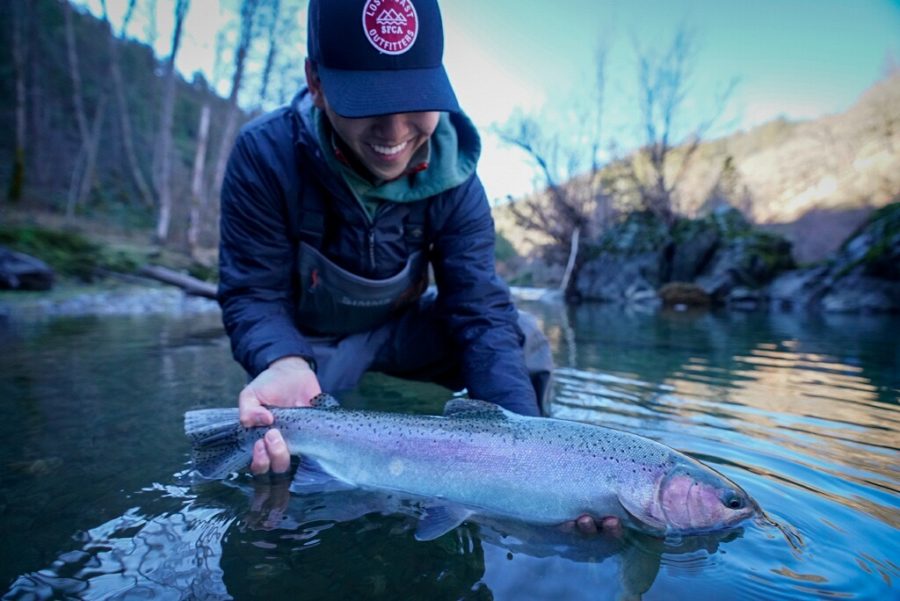Dams scale back steelhead trout population as California cancels salmon season
Cash Bolos ’23 displays a steelhead trout he caught in the Trinity River.
March 27, 2023
On March 16, the California Department of Fish and Wildlife canceled salmon season for all of 2023, citing the years of drought that affected the coveted fish’s ability to breed enough to populate the waters that wind through the Golden State.
The announcement sent waves through the fishing industry, with those who depend on the salmon season for their livelihood scrambling to find ways to support themselves. But while many are focused on salmon, others zero in on steelhead trout.
Steelhead trout are a magical fish that people chase all over the world. They are very similar to rainbow trout, but take on a different way of life by running out into the ocean to eat, and grow dramatically.
The major difference from rainbows is their size, being much bigger and more rounded, and their hue is a lot more chrome and silver-colored. Fly fishermen in particular pursue them from Kamchatka, Russia, to the Olympic Peninsula, to Northern California.
The most popular way to catch them is using a spey rod and swinging flies at them. This is a tedious process of casting, swinging the fly, taking a step, and then repeating the process over and over again.
Many people go months, and even years without catching any because everything must align in order to catch the steelhead. All of the conditions must come together perfectly. Most importantly, and probably the easiest part, is the fish needs to be in the river where your fly swings in front of its face to eat it–finally getting hooked.
Employees at Lost Coast Outfitters, a fly shop in downtown San Francisco, had some advice about steelhead.
Jon said, “Since I first started fishing for them, I’ve caught more because I’ve become a better angler.”
He also said, “I’ve become better, but my favorite rivers are low, sometimes so low they close them to all fishing.”
“Also, when I tail that fish, I know for the most part it’s never been held in human hands before. That’s crazy. I’ve caught trout with flies in their mouths. Steelhead are incredible.”
He added, “If you want to catch one on the swing, you need to work. It doesn’t come easy. You can shorten the learning curve, but you can’t buy a steelhead. Not on the swing at least.”
Another coworker, Ariel, said, “The first and most impactful change I have noticed is the consistent decrease in returns of fish in the Pacific Northwest coastal and inland river systems that support a steelhead population.”
“What is intriguing to me about steelhead is mostly the amount of distance they cover to return to their spawning grounds within a year’s time,” Ariel said. “Also the fact that they are a tough and resilient salmonid species that survives miles and miles of migration through the salty ocean and of course fresh water as well. And their aggressive nature towards a well swung fly.”
William Wolcott ’23 acknowledged that like the salmon, “Population is going down, and what’s intriguing about them is the journey back to their spawning waters.”
One of the most famous rivers in California, the Klamath River, has been greatly impacted by dams, being the biggest downfall for steelhead globally. It makes it way more difficult for them to run up the river and spawn, leading to decreases in wild populations.
Not only in the Klamath, but in many other rivers in the country people are working tirelessly to get the dams removed to try and return steelhead to their natural state. In 2023 the dams are supposed to be removed and wild populations are expected to begin to thrive again.
There are a few key aspects to fishing for steelhead. One, the low populations causing small run amounts and less fish spawning and running back out. And secondly, the magic behind the fish and how enchanting it is to fish for them and hopefully finally catch and tail one.
As a collective for fishermen, people in the community, the ecosystem, and especially for the fish themselves, some believe governmental agencies need to act soon to try and protect this species before it is too late, and they continue down this road where they become extinct.
Supporters believe the first and most influential step would be to remove all dams so that the rivers are free flowing and so that the fish can run out into the ocean and up into rivers to spawn easier without dams and fish ladders in their way, making it exponentially more difficult for them.

